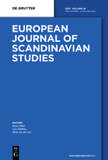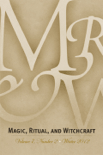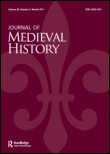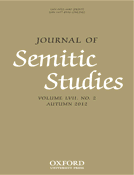
JOURNAL OF INDO-EUROPEAN STUDIES
Scope & Guideline
Unveiling the Rich Tapestry of Language and Culture
Introduction
Aims and Scopes
- Linguistic Analysis and Etymology:
The journal publishes detailed studies on the etymology and phonology of Indo-European languages, exploring their historical development, connections, and unique features. - Cultural and Religious Studies:
Research often delves into the cultural practices, religious beliefs, and mythologies of Indo-European societies, providing insights into their worldviews and social structures. - Archaeological Perspectives:
The journal integrates archaeological findings with linguistic and cultural studies, examining how material evidence informs our understanding of Indo-European peoples and their migrations. - Comparative Studies:
Consistent comparative analyses of different Indo-European languages and cultures are a hallmark of the journal, showcasing similarities and divergences that illuminate broader historical narratives. - Historical Contextualization:
Papers frequently contextualize Indo-European studies within broader historical frameworks, addressing the implications of language and culture on societal development across time.
Trending and Emerging
- Interdisciplinary Approaches:
A growing trend in recent publications is the integration of linguistic, archaeological, and anthropological perspectives, indicating a shift towards more holistic studies that encompass multiple facets of Indo-European heritage. - Gender Studies in Indo-European Contexts:
There has been an increase in research focusing on gender roles and representations within Indo-European societies, revealing the complexities of social structures and cultural narratives. - Cognitive Linguistics and Semantics:
Emerging themes include cognitive linguistic approaches to understanding Indo-European languages, with a focus on semantics and the cognitive underpinnings of language and meaning. - Contemporary Relevance of Indo-European Studies:
Recent publications are increasingly addressing the relevance of Indo-European studies to contemporary issues, such as identity, nationalism, and cultural heritage, reflecting a broader societal engagement with historical narratives. - Environmental and Ecological Linguistics:
There is a budding interest in exploring how Indo-European languages and cultures relate to environmental and ecological themes, which may inform discussions on sustainability and cultural adaptation.
Declining or Waning
- Focus on Early Indo-European Origins:
There has been a noticeable decrease in papers specifically dedicated to the earliest origins of Indo-European languages, possibly indicating a shift towards more contemporary linguistic studies or a saturation of existing research. - Phonological Studies of Lesser-Known Languages:
Research focusing on the phonology of less widely studied Indo-European languages has been declining, potentially due to a greater emphasis on more prominent languages such as Latin, Greek, and Sanskrit. - Mythological Comparisons:
Papers that engage in comparative mythology across Indo-European cultures have diminished, suggesting a possible waning interest in mythological frameworks or a move towards more empirical and less interpretative studies. - Traditional Indo-European Studies:
There appears to be a decline in traditional methodologies that focused heavily on philological approaches, as scholars increasingly adopt interdisciplinary methods that incorporate modern theoretical frameworks.
Similar Journals

European Journal of Scandinavian Studies
Advancing the frontiers of Scandinavian scholarship.European Journal of Scandinavian Studies is an esteemed journal published by Walter de Gruyter GmbH, dedicated to advancing scholarship in the fields of Cultural Studies, Linguistics and Language, and Literature and Literary Theory. Since its inception in 2010, the journal has been a pivotal platform for researchers and scholars, showcasing cutting-edge research and critical discussions pertaining to Scandinavian languages and cultures. With an ISSN of 2191-9399 and an E-ISSN of 2191-9402, the journal emphasizes accessibility to impactful academic work, despite its current non-open access model. While the journal is categorized within the Q4 quartile for Cultural Studies and Linguistics/Language, it has shown notable potential in ranking higher in its specialized domains, fostering a growing community of researchers invested in Scandinavian studies. The journal's office is located in Berlin, Germany, further enriching its European scholarly context. As it continues to evolve, the European Journal of Scandinavian Studies serves as a vital resource for academics seeking to engage deeply with the multifaceted aspects of Scandinavian culture and linguistics.

Magic Ritual and Witchcraft
Unveiling the Intersections of Culture and the SupernaturalMagic Ritual and Witchcraft, published by UNIV PENNSYLVANIA PRESS, is a pivotal journal in the fields of Cultural Studies, History, and Religious Studies, recognized for its scholarly contributions since its inception in 2014. With a strong focus on the interdisciplinary nature of magic and ritual practices across cultures, this journal provides a platform for original research, critical reviews, and theoretical discussions that illuminate the complexities of these phenomena. Operating from the heart of the United States, Magic Ritual and Witchcraft has attained a commendable standing within its category quartiles, ranked Q2 in 2023, indicating its significance and reach within the academic community. Despite not being an open-access journal, its articles are accessible through libraries and institutions, ensuring that this essential body of work reaches a diverse audience of researchers, professionals, and students passionate about the intersections of culture, history, and the sacred. As the dialogue around ritual practices continues to evolve, this journal remains an invaluable resource for advancing scholarship and fostering insights into the magical dimensions of human experience.

GLOTTA-ZEITSCHRIFT FUR GRIECHISCHE UND LATEINISCHE SPRACHE
Fostering Dialogue in the Classics CommunityGLOTTA-ZEITSCHRIFT FUR GRIECHISCHE UND LATEINISCHE SPRACHE, published by Vandenhoeck & Ruprecht GmbH & Co KG, stands as a pivotal academic journal within the field of Classics and Linguistics, demonstrating a strong commitment to advancing scholarly discourse surrounding the Greek and Latin languages. With a respectable Scopus ranking placing it in the top 77th percentile for Classics, this journal facilitates the dissemination of high-quality research and insights relevant to linguists, philologists, and historians alike. The journal operates without an open access model, ensuring its niche scholarship remains exclusive yet profoundly impactful. The HIndex is indicative of its longstanding influence, with the journal traces its roots back to its inception, with weighted contributions across several pivotal years. Furthermore, the journal's current standing—positioned in the Q2 quartile for Classics and Q3 quartile for Linguistics—reflects its thriving relevance and aspiration towards academic excellence, offering a significant platform for the exchange of ideas within the global scholarly community. Researchers, professionals, and students are encouraged to engage with the journal's contributions, as it consistently reflects the evolving dialogue in the study of ancient languages.

REVUE DE LINGUISTIQUE ROMANE
Fostering Interdisciplinary Dialogue in LinguisticsREVUE DE LINGUISTIQUE ROMANE, published by the esteemed SOCIÉTÉ LINGUISTIQUE ROMANE, is a prominent academic journal dedicated to the exploration of Romance linguistics. With its ISSN 0035-1458, the journal plays a significant role in advancing knowledge within the fields of linguistics and the history and philosophy of science. Although it does not currently offer Open Access, it provides critical insights and peer-reviewed research that are indispensable for scholars, educators, and students interested in the nuances of Romance languages. The journal, which has seen converged coverage from 2006 to 2017, and then again from 2019 to 2021, is ranked in the third quartile (Q3) across various categories within Scopus, reflecting its established presence in the academic community. As a vital resource for interdisciplinary studies, REVUE DE LINGUISTIQUE ROMANE is instrumental for those seeking to deepen their understanding of linguistic structures, cultural nuances, and the historical development of Romance languages.

RIVISTA DI STORIA E LETTERATURA RELIGIOSA
Connecting Historical Contexts with Literary ExpressionRIVISTA DI STORIA E LETTERATURA RELIGIOSA, published by CASA EDITRICE LEO S OLSCHKI, is an esteemed Italian journal dedicated to the interdisciplinary exploration of religious literature and its historical contexts. With an ISSN of 0035-6573 and an E-ISSN of 2035-7583, this journal serves as a platform for scholarly dialogue among researchers, professionals, and students in the fields of Literature, Religious Studies, and the Visual and Performing Arts. Although classified in the Q4 quartile for its categories in 2023, the journal presents a unique opportunity for contributors to engage deeply with underrepresented narratives and theories, thus fostering a richer understanding of the intersections between literature and religion. While currently not available as open access, the journal's poignant insights and rigorous scholarship make it a critical resource for those seeking to deepen their knowledge in these rich and diverse fields.

Sibirskii Filologicheskii Zhurnal
Bridging Cultures Through Language and LiteratureSibirskii Filologicheskii Zhurnal is a prestigious academic journal published by the Russian Academy of Sciences, Institute of Cytology and Genetics. With ISSN 1813-7083, it is dedicated to advancing research in the fields of Cultural Studies, Linguistics and Language, and Literature and Literary Theory, and has achieved notable rankings, including Q2 in Cultural Studies and Linguistics, and Q1 in Literature for 2023. The journal provides a platform for scholarly discourse, contributing valuable insights to its fields with an evolving scope that spans from 2018 to 2024. Though not an open-access journal, Sibirskii Filologicheskii Zhurnal serves as a vital resource for researchers, professionals, and students in the Russian Federation and beyond, fostering a deeper understanding of linguistic and literary phenomena. Its commitment to high-quality content makes it an essential addition to any academic's library.

Studi e Saggi Linguistici
Advancing the Frontiers of Linguistic ResearchStudi e Saggi Linguistici is a distinguished academic journal published by EDIZIONI ETS, based in Pisa, Italy. With its ISSN 0085-6827, this journal has established itself as a vital resource in the field of linguistics, particularly noted for its contributions since its inception in 2016. Although currently categorized in the lower quartile (Q4) by the 2023 metrics in the domains of Linguistics and Language within Scopus, it remains a significant platform for innovative research and critical discussions surrounding language studies. Focusing on both theoretical and practical aspects of linguistics, the journal serves as a nexus for scholars and practitioners alike, facilitating a rich interchange of ideas and knowledge in a rapidly evolving discipline. As an invaluable publication for researchers, professionals, and students, Studi e Saggi Linguistici is committed to advancing the understanding of linguistic phenomena and fostering scholarly communication in its field.

ZEITSCHRIFT FUR SLAVISCHE PHILOLOGIE
Unveiling the Richness of Slavic LanguagesZEITSCHRIFT FUR SLAVISCHE PHILOLOGIE is a pivotal journal in the field of Slavonic philology, published by Universitatsverlag C Winter Heidelberg GmbH. Renowned for its scholarly rigor and insightful contributions, this journal serves as a key platform for researchers, professionals, and students interested in Slavic languages and linguistics. Despite its classification as a traditional subscription journal, it has maintained a consistent presence in the academic community with contributions that enhance understanding of linguistic, cultural, and literary studies within the Slavic context. With an H-index reflecting its impact and relevance, the journal has historically been indexed in Scopus, ranking in the 34th and 33rd percentiles within the Arts and Humanities and Social Sciences categories, respectively. The journal has featured a range of scholarly articles from 2002 to 2017, providing a rich repository of knowledge for those dedicated to the study of Slavic languages. For any researcher aiming to delve into this dynamic field, ZEITSCHRIFT FUR SLAVISCHE PHILOLOGIE remains an essential resource.

JOURNAL OF MEDIEVAL HISTORY
Bridging Eras with Insightful Medieval ResearchJOURNAL OF MEDIEVAL HISTORY, published by Routledge Journals, Taylor & Francis Ltd, stands as a vital resource in the field of historical studies, focusing on the complex tapestry of the medieval period from 1975 to 2024. With an ISSN of 0304-4181 and E-ISSN of 1873-1279, this journal boasts an impressive Q2 categorization in History, ranking #502 out of 1760 in the Scopus Arts and Humanities rankings, placing it in the top 29% of its field. The journal aims to publish high-quality, innovative research that enhances the understanding of medieval history, making it an indispensable read for scholars, practitioners, and students alike. While it does not currently offer Open Access options, its reputable standing ensures that it reaches a wide audience dedicated to exploring the intricacies of the medieval era. Engage with cutting-edge scholarship and historical insights that collectively contribute to the advancement of medieval studies.

JOURNAL OF SEMITIC STUDIES
Exploring the Depths of Semitic HeritageJOURNAL OF SEMITIC STUDIES, published by Oxford University Press, is a premier academic journal that has served as a vital platform for interdisciplinary research in the fields of Semitic languages, history, culture, and religion since its inception in 1956. With a distinguished impact factor and a significant presence in various academic quartiles, including Q1 rankings in History and Literature, this journal is essential for scholars and practitioners seeking to advance their understanding of Semitic studies. The journal's scope includes comprehensive research articles, critical essays, and reviews that contribute to ongoing dialogues in Cultural Studies, Linguistics, and Religious Studies, making it indispensable for researchers, educators, and students alike. Although it currently does not offer open access, the high-quality, peer-reviewed content ensures rigorous academic standards while maintaining engagement with current trends and discussions in its respective fields. As a hub for innovative and influential scholarship, the JOURNAL OF SEMITIC STUDIES continues to foster an environment that encourages exploration and discovery within the rich tapestry of Semitic languages and cultures.